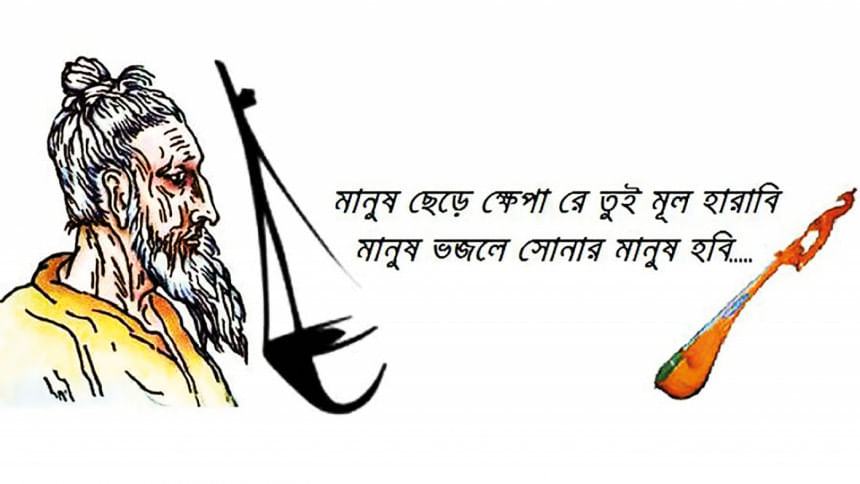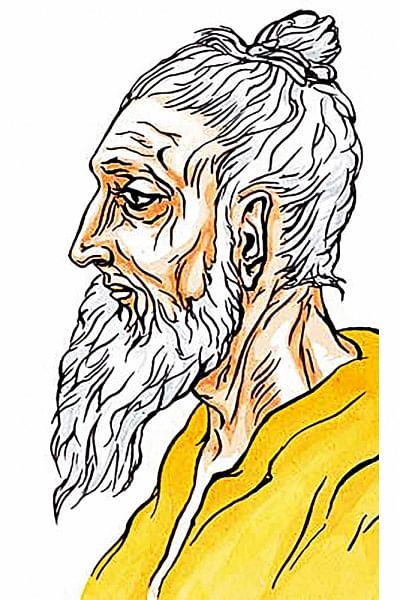Fakir Lalon Shah: Subjects, Sites, and Signs

Fakir Lalon Shah—who orally composed thousands of songs in Bengali —died on October 17, 1890—on Kartik 01, 1297 (the Bengali year). This year, then, marks his 130th death anniversary. Of death—of its being and non-being, its arrival-before-arrival—Lalon sings on varying registers, as he also sings of life and love and liberation. But what about his own birth? The actual details of his birth are still unknown, while his own silence surrounding his birth is persistently audible like a waterfall! But it is generally believed that he lived for 116 years. The year 1774, therefore, is usually taken to be the year of his birth. Lalon lived, worked, and died in the village of Chheuriya, near Kushtia (a town in Bangladesh), during British colonial rule.
It is a formidable challenge to introduce an unusual figure like Fakir Lalon Shah, given that his work tends to resist translation and even interpretation, let alone hermeneutic excavation, by those who are non-initiates, although interpretive violence continues to be perpetrated on him. Contrary to certain conventional characterizations, Lalon—who had no formal or institutional education—is not a mystic or a metaphysician in the Western senses, nor is he even a "musician" in the traditional sense of the term. He is not even a Baul, as he never identified himself as one, nor is he a Sufi sensu stricto.

But it is possible to identify in his work a unique and even unprecedented mélange of Buddhist, Hindu, Islamic, and Jainist elements. Put another way: Lalon's songs and practices—in a number of instances—embody and enact an interplay among certain aspects of the Buddhist Shahajiya path, Gaudiya Vaishnavism, and even the Kartabhaja, while he also ranges beyond them resisting facile syncretism and eclecticism.
For me, then, Lalon is simultaneously a song-composer, singer, poet, thinker, theorist, practitioner, and a Faqir for sure. And his Faqiri—integral to his life and work—designates, among other things, a thoroughgoing path of sadhana under the guidance of the Guru—a path constituted by life-changing yet life-realizing revolutionary practices, a path that organically combines the musical and the poetic and the political all at once, to say the least—although a caveat must be registered here: Lalon cannot be pigeon-holed into a water-tight compartment in the final instance.
It is also important to point out that Lalon has been not only canonized—and even assimilated into academia—by the Bengali middle class, but also commodified, corporatized, de-historicized, even de-radicalized. The question here, however, is not one of rescuing and recuperating a pure Lalon Fakir as such, but it at least involves our struggle to make sense of his work in its actual contexts. And to speak of such contexts—the historical one included—is to call attention to the Nadiya school of thought—a movement in its own right—that flourished under the influence of Islam during the time of Alauddin Husain Shah, who ruled from 1494 to 1519.
That was indeed a time which witnessed a remarkable efflorescence of Bengali literary works accompanied by more than one Bengali adaptation of the Mahabharata and the production of the great Manasamangal Kavya by Bijay Gupta, one who—as the literary historian Sukumar Sen tells us—compares Alauddin Husain Shah to none other than Arjuna himself. And, no less significantly, this was a time that witnessed the rise of the figure of Sri Chaitanya—a fifteenth-century sadhak, based in Nadiya and known for his influential Achintya-Bheda-Abheda tattva (which can roughly be translated as the "inconceivable difference-and-oneness-unity theory"), one that Lalon re-invents and re-mobilizes on a range of registers.
In addition to Chaitanya, one should mention two other figures such as Nityananda and Advaita Acharya. Lalon himself characterizes the trinity of these radical figures as "tin paagal," ones who variously inform and inflect and energize Lalon's positions and practices, although, of course, Lalon inaugurates his own, even new, mode-of-being in that tradition which was fundamentally opposed to hierarchies and oppressions based on caste, class, religion, and patriarchy, for instance.
Within—and ranging beyond—that tradition, Lalon could sing: "People ask, what is Lalon's caste? / Lalon says, my eyes fail to detect/ the signs of caste." And then he moves in the direction of questioning and even unsettling the scriptures-based semiotics of discrimination in the same song: "A Muslim is marked by the sign/ of circumcision; but how should/ you mark a woman? / If a Brahmin male/ is known by the thread he wears, / how is a woman known?"
2
Owing to space constraints, it is impossible to do justice to the entirety of Lalon's work, massive as it, nor is it possible to dwell on the details of profound transactions and tensions between Sri Chaitanya and Lalon Fakir. However, at the risk of simplifying many issues, I will call attention to only a few areas of Lalon's work that I find significant.
So, as for the Chaitanya-Lalon relationship, one may easily identify their common concern with the One and the body in the first place. In a song, Lalon himself makes it clear how he dissolves "the raft of signs, the marks of caste" in the deluge of the One; while, in another song, Lalon musically turns to the mathematical in order to underline the One thus: "Four zeroes after nine:/Ninety thousand—says the document:/ But erase all the zeroes/You've the play of only nine./Deduct eight from nine/ You've the One in the end."
By no means akin to the Greek philosopher Parmenides's cosmic principle that "all is One," Lalon's "One" dissolves the borders and boundaries between the living being and the Param (the 'Absolute'), suggesting their indivisibility, which, however, is not an axiomatic given as such, but which is to be achieved via the path of sadhana under the active guidance of the Guru. In fact, in Lalon's songs, the dichotomy between what are called "Subject" and "Object" is also dissolved in the One. And the One—by no means a transcendental state of being—comes to reside in the body itself.
The body, indeed, constitutes the key site with which Lalon's songs and practices remain persistently preoccupied. As Lalon puts it in one of his songs: "What you are frantically looking for across the sky and the earth/ resides in this body." In yet another song: "If you don't know your body/ How would you know the real theory of the self?" It's instructive that Lalon directly uses the word "tattva" (theory)—and dehottatva (theory of the body) and atmattatva (theory of the self) as well—in his songs on numerous occasions, giving us the impression that theorizing-as-practice and creativity are by no means mutually exclusive. In fact, Lalon even theorizes directly yet poetically and profoundly in the spaces of his songs, running against the grain of those anti-theoretical, self-absorbed aesthetes, who, under the spell of bourgeois and even colonialist poetics, tend to harbor the very idea that theory disfigures or damages the poetic as such.
In any event, Lalon's preoccupation with the body is significant on more scores than one. Of course, the body remains almost a universal constant in a number of mystical traditions across the world—from, say, Blake to the Bauls. The old tantric tradition itself, preceding the Nadiya school of thought, valorizes the body to varying degrees, while, however, tending to use the body as a means to accomplishing something—the Param, for instance—positing thereby a gap between the two. But what is distinctive about Lalon is that he closes that gap, suggesting that the body, being, and the Param are indivisibly One, their differentia specifica notwithstanding.
In other words, for Lalon, the body cannot simply be reduced to a means or a mode of mediation, given that the very being and the Param—and by extension, the universe itself—reside together inside the body which remains manifest, immanent, and active all at once in ways in which it turns out to be more than a biological body as such. The hint here is this: There's nothing outside the body and, by extension, there is nothing outside human beings themselves.
But Lalon is not a traditional "radical humanist," nor is he an anthropocentric thinker in the final instance, given that he remains acutely attentive to the entirety of living beings, to all life-forms, and that—in his work and world—the body itself cannot be separated from Nature and vice versa. To simplify the point: For Lalon, to hurt Nature is to hurt the body itself. As for the ways in which Lalon sings of manush bhojona—his foremost and fundamental concern—Lalon decisively runs against the grain of the "I"-based Renaissance humanism that remains dominant in the Western world. In fact, Lalon aims at the dissolution of the self-invested "I" in favor of the One, which, however, remains more material than mystical in that the One and the body—materially present as it is—remain inseparable from one another.
Indeed, Lalon's musical enactment of the embodied One blasts open the continuum of colonial power/knowledge that otherwise dominated the minds and imaginations of many of his ostensibly progressive contemporaries in the nineteenth century. Indeed, Lalon can be regarded as the most remarkable oppositional figure—an exemplary anti-casteist, anti-patriarchal, anti-colonial figure—in undivided Bengal in the nineteenth century.
Given the extraordinary range and rigor of Lalon's preoccupations, I've hitherto only scratched the surface of his work. But I hope one can at least make sense of some of his concerns that remain relevant to our struggles against all forms and forces of oppression and injustice in a world devastated by capitalism, colonialism/imperialism, racism, and patriarchy, profoundly interconnected as they are.
Azfar Hussain teaches in the Integrative, Religious, and Intercultural Studies Department within the Brooks College of Interdisciplinary Studies, Grand Valley State University in Michigan, and is Vice-President of the Global Center for Advanced Studies, New York, USA.

 For all latest news, follow The Daily Star's Google News channel.
For all latest news, follow The Daily Star's Google News channel. 



Comments